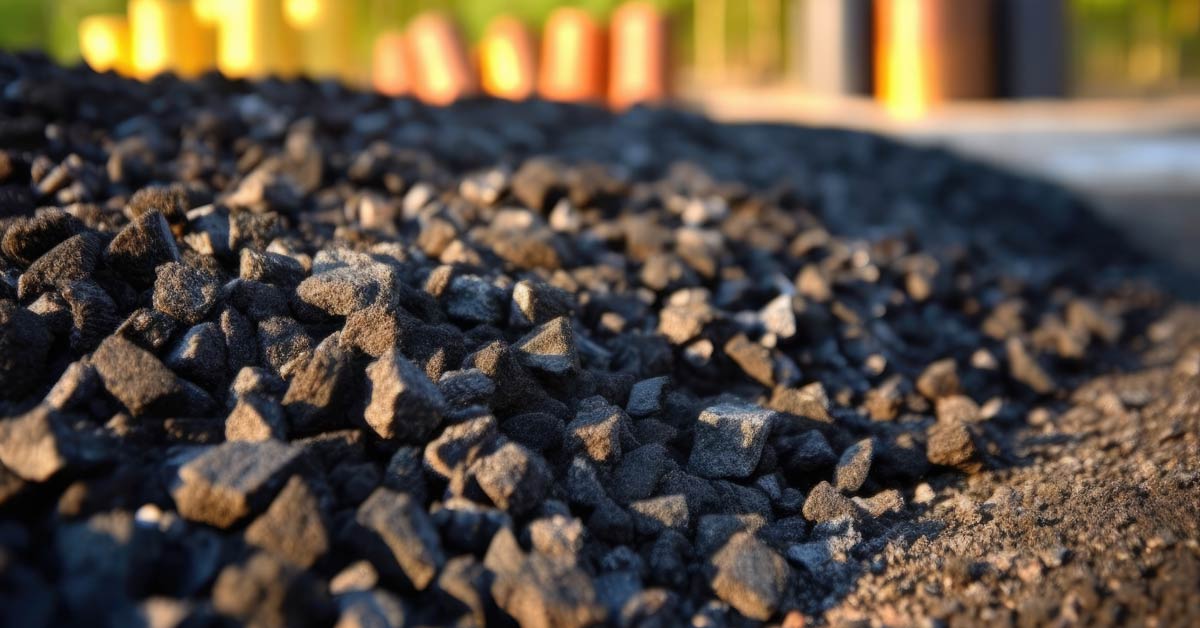6 min read
Biochar: Huge Potential in Biofuels and Renewable Energy
ResourceWise
:
Nov 7, 2023 12:00:00 AM

In the race toward renewables, new innovations continue to move the dial forward toward achieving our energy goals while decreasing carbon output. One of the most exciting developments in this space is from a substance known as biochar.
What is Biochar?
In simple terms, biochar is similar to charcoal. It's made from the burning of biomass—from sources such as forestry and agricultural wastes. While the burnt appearance resembles charcoal, its production is considerably different.
This post will dive into the various aspects of biochar, including its uses and potential as a carbon-reducing biofuel and substitute in many traditional fossil fuel use cases.
How is Biochar Produced?
Biochar begins its lifecycle as organic materials. Wood chips, leaf litter, dead plants and other materials are typically used to create this product. Many of these substances originate as waste in places like a sawmill or residential leaf and lawn waste.

These materials are gathered and put through a process known as pyrolysis. Pyrolysis is the rapid decomposition of organic matter performed at very high temperatures.
Pyrolysis is not quite the same as simple burning. Regular burning of these materials is messy in terms of contamination and expressed carbon. Pyrolysis works by conserving carbon and reducing the pollution that would be created by fumes.
Production containers are depleted of most of the oxygen before the burning process occurs. This breaks down the organic materials without releasing any of their innate carbon through smoke or fumes.
Traditional burning is much less efficient, and biochar stabilizes carbon to help prevent its release into the atmosphere. This makes it a much cleaner conversion process with an array of further uses and benefits.
What Feedstocks Does Biochar Use?
More recently, biochar technology has enjoyed an immense push into the realm of renewable fuels. Again, the substance's composition is a carbon-rich "stable solid" made through the low oxygen combustion process. This solid brings with it immense potential in fueling our collective renewable future.
The general chemical composition varies depending on the types of materials used in biochar's creation. Common substances include woody biomass from forest products, lumber production, and even agricultural waste. These can be subdivided even further into tree species, types of wood products like chips or yard waste, and types of agricultural products like corn stalks.
Additionally, temperature can also vary to yield biochar. The material is produced at a temperature range from 300-700C. How much-required heat varies based on the feedstocks used to create the biochar. But the final substance—recalcitrant carbon—persists in all forms of the product.
Is Biochar a Biofuel?
Biochar offers a variety of uses and applications as a biofuel. It contributes directly to the carbon transition in several different ways.
Gives New Life to Waste Products
Feedstocks used to produce biochar include the following:
- Wood Chips (Leftovers from Mills)
- Paper Mill “Sludge” (Byproduct Waste)
- Yard Trimmings, Tree Branches, etc.
- Rice Hulls
- Switchgrass
- Corn Stalks
- Wheat Straw
- Peanut Shells
- Animal Manure
In all these cases, the byproducts would typically end up in a landfill as waste. Biochar, however, conserves the energy in these wastes by repurposing it into fuel and carbon sinks. Even the burning process salvages gases which can be converted into liquid fuel.
The Material Can Be Used as a Long-Term Carbon Store
As mentioned, when mixed into soil, biochar can help improve its health and absorb heavy metals and other toxins. From a carbon storage perspective, it also offers long-term benefits.
The pyrolysis burning process makes the substance much stronger and robust as a carbon sink. This means that it can remain in the soil as carbon far longer than the normal decomposition process. Keeping carbon in the soil means less of it in the atmosphere, contributing to global emissions standards and objectives.
It Can Also Be Used as a Burning Fuel
The material can also be burned similarly to normal charcoal as a fuel for stoves or even grills. It burns cleaner than charcoal with far fewer gaseous emissions and carbon remaining in the powdery ash left over.
Captured Gases Can Be Used as Liquid Biofuel
Pyrolysis occurs in a concentrated burn box to conserve as much as possible from the process. The burning of woody biomass and agricultural waste leads to the release of gaseous byproducts. These can be captured and converted into liquid biofuels.
These liquid biofuels help to reduce the reliance on fossil fuels. Renewable materials previously discarded as waste products can now be efficiently converted into fuels that can power industrial applications, vehicles, and more. Over time, this will significantly reduce the overall carbon footprint in these traditionally carbon-heavy operations.
Does Biochar Help Soil?
Traditionally, biochar has long been used as an additive to improve soil health. According to the USDA Forest Service, converting wood waste to biochar and adding it to soil offers two important benefits:
1. Enhancing Overall Nutrient Retention
Woody residue biochar can be integrated with soil to help keep it nutrient-dense and supportive of plant growth and establishment. Its condensed form delivers a high degree of organic matter directly into the ground. This can better deliver nutrients which will help plants establish a healthy start and root system.

Similarly, the material can stop nutrient leaching and better retain water. The material’s composition in soil allows it to better retain water for an extended time. This reduces irrigation needs when growing native plants in a region.
2. Remediation to Clean Contaminated Sites
Zooming in the lens to the microscopic level, biochar's molecular structure is similar to a honeycomb. This structure allows it to bond with other elements in the soil such as nutrients, improving retention for plant growth.
Even better, it can bond with heavy metals or other potential soil contaminants. This helps with stormwater management by preventing these pollutants from leaching out into groundwater. It also helps in soil reclamation in spots such as mining or other industrial sites with potential contamination.
What Is Low Carbon Black (Recovered Carbon Black)?
Another product made through pyrolysis is carbon black. Carbon black is a material typically made from used tires. Low-carbon black, or recovered carbon black (rCB), is the reusable version of this substance created through the same process as biochar.

Recovered carbon black uses recycled tires, putting them back into the production of new stock and other rubber-based industrial and manufacturing products. This reintegrates otherwise wasted materials back into the value chain through relatively low energy usage.
Recovered carbon black can help conserve up to 80% of the carbon required for tires. Alongside rCB, this will directly contribute to meeting carton transition goals.
What is the Difference Between Biochar and Torrefied Black Pellets?
You may have also heard of a similar-yet-distinct biofuel source known as torrefied black pellets. Torrefied black pellets and biochar are both biofuels, yet they differ significantly in their composition and applications.
The processes of creating biochar and torrefied black pellets, pyrolysis and torrefaction respectively, have distinct differences.
Torrefaction involves heating biomass in a low-oxygen environment at temperatures ranging from 200°C to 300°C. The biomass partially decomposes, giving the resulting pellets an increased energy density, carbon content, and water-resistance.
Read More: Torrefied Black Pellets: A Key Player in the Carbon Transition
Pyrolysis, used in the production of biochar, also involves heating biomass in a low-oxygen environment. However, this process occurs at higher temperatures, typically between 300°C and 700°C.
This process yields solid biochar, liquid bio-oil, and syngas. Biochar serves as a soil amendment and a renewable energy source, while the co-products, bio-oil and syngas, can be further used for energy generation.
Torrefied black pellets are created through the heat treatment of biomass. They are primarily used for co-firing in power plants due to their high energy density and hydrophobic nature.
Conversely, biochar is a carbon-rich product made from a variety of waste materials and is used for capturing and holding carbon in the soil, with a growing potential for energy production.
What are the Benefits of Biochar?
Fully Renewable Fuel Source
Biochar is sourced from sources such as wood and agricultural products which can be continuously grown. Without relying on finite fossil fuels, its use will be imperative in the transition to 100% renewable fuel.
Utilizes Waste Products for Fuel
Materials that would have otherwise ended up in a landfill are used to produce biochar. The fuel source is already comprised of renewable materials. Adding materials that would have otherwise been unused adds even more efficiency to the process.
Uses Captured Gases for Further Conservation
Again, gases released during pyrolysis are captured and used to create liquid biofuels. Like waste products, utilizing these gases serves to increase material conservation and efficiency to an even greater degree.
Stores Carbon Long-Term
When pyrolysis finishes, the end product offers several benefits to help enrich soil. Even if biochar is only used in soil, it sequesters carbon in the soil for years, decades… perhaps even centuries or more.
The carbon contained therein means less released into the atmosphere. Thus, even when left as a soil additive, it directly aids in decreasing carbon emissions.
Challenges and Criticisms of Biochar
Risk of Land Exploitation
The only way a fuel source can work is by receiving enough feedstocks to power it. Ideally, biochar uses leftover ingredients and components to power its production. But this may not always be the case.
Sometimes, producers may be pressured to grow feedstocks to help power biochar. This pressure could directly interfere with growing operations in a specific region.
The emerging risk comes in the land used to produce these feedstocks. If the need for feedstocks keeps growing, landowners and producers will have to respond accordingly.
This could lead to the potential exploitation of land plots to focus on faster-yield crops—a practice known as indirect land use change. If land used for growing food changes into a feedstock plot for biochar, this could worsen issues such as global food insecurity.
Higher Energy Usage Transporting Feedstocks
A big challenge comes in the way of biochar’s energy footprint. Feedstocks must be shipped to production facilities. Those shipments require fuel and energy.
How much energy depends on the facilities and the feedstocks. However, many critics note that the logistics could significantly affect the potential carbon savings these materials offer.
Read more about biofuels and their growing importance within the energy value chain.





